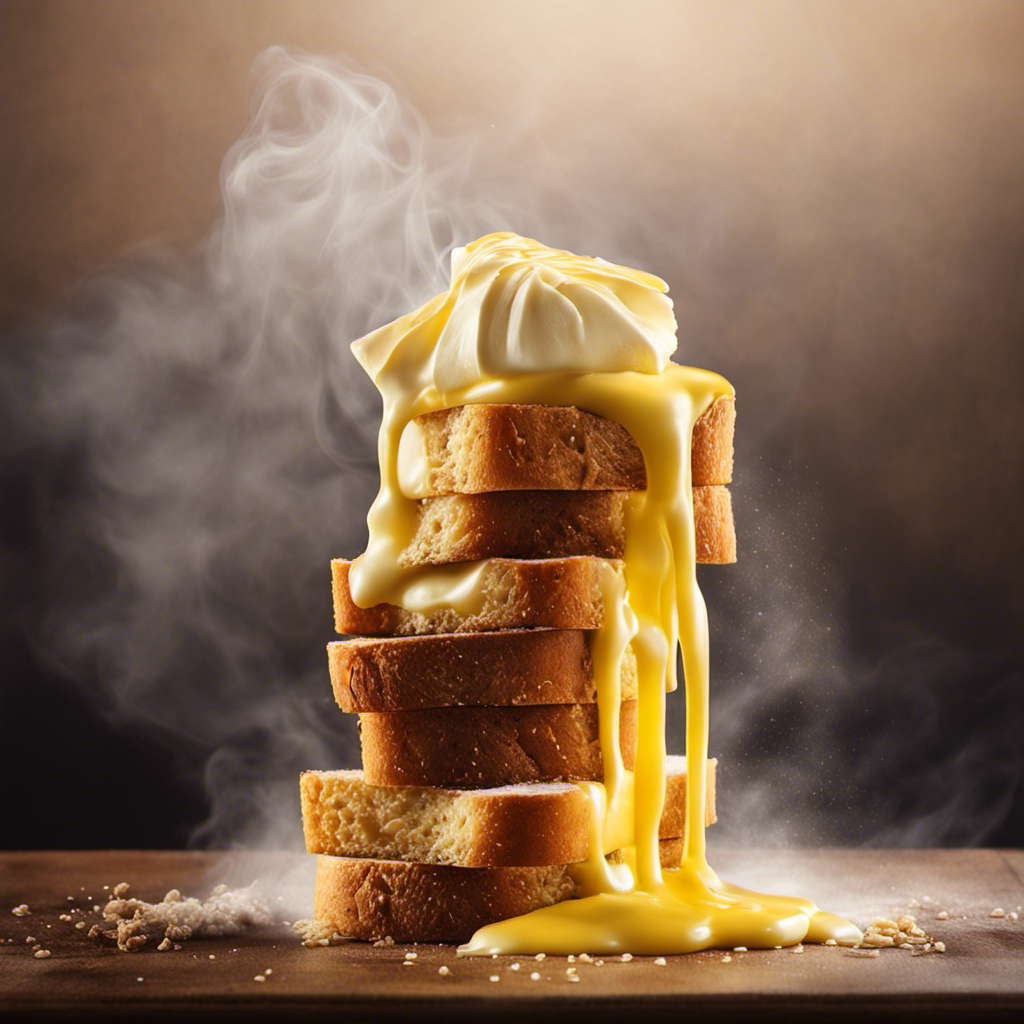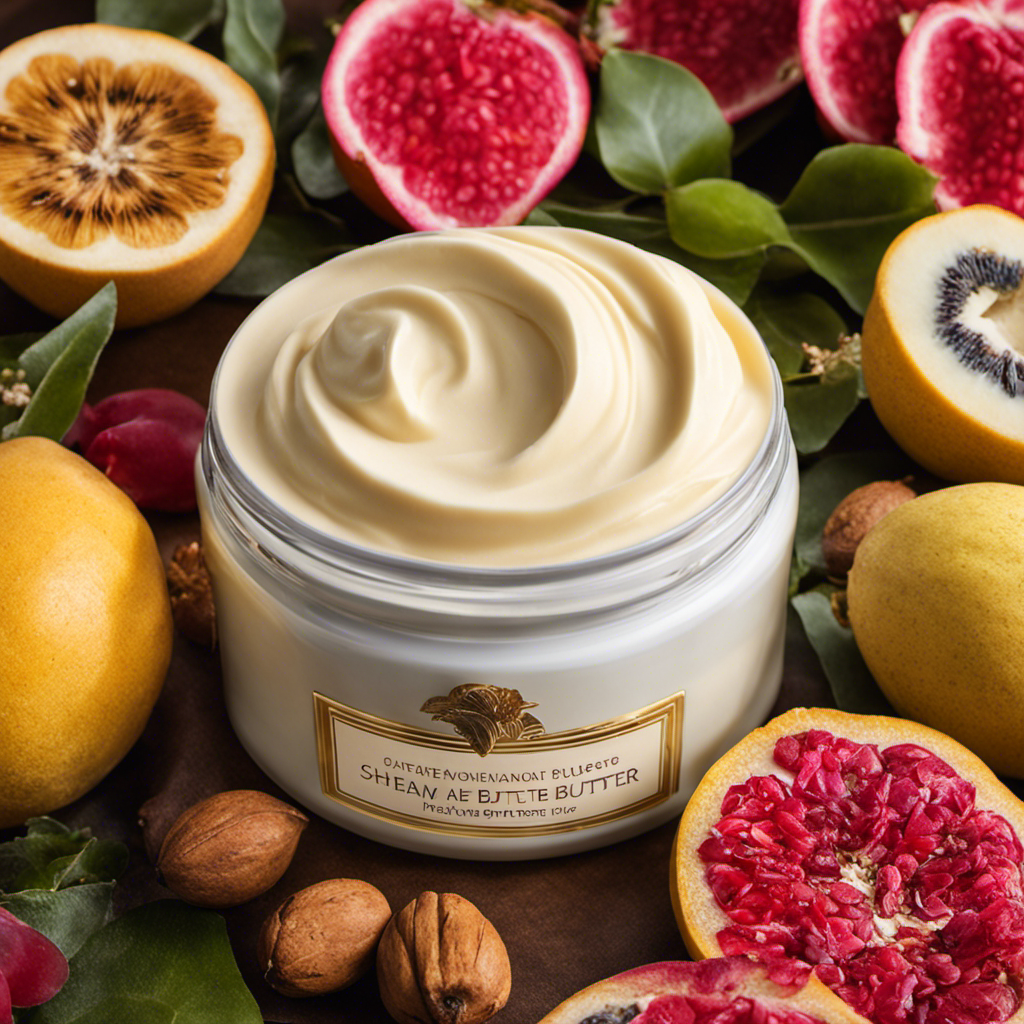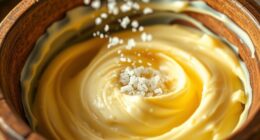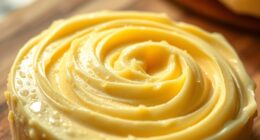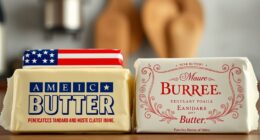As a lover of all things indulgent and delicious, I have always been fascinated by the mysterious world of butter flavoring. What is the special ingredient that gives our favorite treats that irresistible taste?
In this article, we will dive into the origins, production methods, and common uses of butter flavoring. From enhancing baked goods to adding a savory touch to popcorn, butter flavoring has become a staple in many kitchens.
Join me on this culinary exploration as we uncover the secrets of butter flavoring.
Key Takeaways
- Butter flavoring is a synthetic compound that replicates the taste and aroma of butter.
- Different types of butter flavoring include garlic butter, honey butter, and truffle butter.
- Butter flavoring is widely used in baked goods, snacks, and dairy substitutes in the food industry.
- Butter flavoring is a good source of vitamin A and can be a suitable substitute for real butter in lactose intolerant or vegan diets.
The Origin of Butter Flavoring
The origin of butter flavoring can be traced back to the early 20th century. It was created to provide a convenient and cost-effective alternative to real butter. Butter flavoring is a synthetic compound that replicates the taste and aroma of butter. The flavor extraction methods used to develop butter flavoring involve a combination of chemical and natural processes.
One common method is the use of dairy-derived compounds, such as diacetyl, which is responsible for the buttery flavor. These compounds are isolated and purified before being combined with other ingredients to create a concentrated butter flavor. Other extraction methods include the use of natural flavors from plants and the synthesis of flavor compounds in a laboratory setting.
The development of butter flavoring has allowed for its widespread use in various food products, providing consumers with the taste of butter without the need for actual butter.
Different Types of Butter Flavoring
You might be surprised by the variety of options available for different types of butter flavoring.
When it comes to butter alternatives, there is a range of flavors to choose from. Some popular options include garlic butter, honey butter, and even truffle butter. These flavorings are created by combining natural or artificial ingredients with a buttery base.
Garlic butter flavoring, for example, often incorporates garlic powder, salt, and other spices to mimic the taste of garlic-infused butter. Honey butter flavoring, on the other hand, combines honey with a buttery essence to create a sweet and savory flavor profile. Truffle butter flavoring is made by infusing the butter with the essence of truffles, resulting in a rich and earthy taste.
With so many different flavors to explore, butter alternatives offer a world of culinary possibilities.
How Butter Flavoring Is Made
When it comes to understanding how butter flavoring is made, it is important to consider the ingredients used in the process, the flavor extraction methods employed, and the application of butter flavoring in the food industry.
The ingredients used in the process can vary, but commonly include natural or artificial flavoring compounds, emulsifiers, and sometimes colorants.
Flavor extraction methods can involve distillation, extraction with solvents, or enzyme-based processes.
In the food industry, butter flavoring is widely used in a range of products such as baked goods, snacks, and dairy substitutes to provide a rich and creamy taste reminiscent of butter.
Ingredients Used in Process
Ingredients used in the process of creating butter flavoring include artificial flavorings, natural flavorings, and various additives.
When it comes to flavoring alternatives, artificial flavorings are commonly used to mimic the taste of butter. They are created in a lab using a combination of chemicals that replicate the distinct flavor profile of butter.
On the other hand, natural flavorings are derived from sources like plants and animals. These can include extracts from butter or other dairy products, as well as plant-based oils.
Additionally, various additives are used to enhance the flavor and aroma of the butter flavoring. These additives can include emulsifiers, stabilizers, and preservatives, which help to maintain the flavor and extend the shelf life of the product.
Flavor Extraction Methods
To extract flavors, different methods are used such as distillation, infusion, and solvent extraction. Each method has its own advantages and is used depending on the desired outcome.
-
Distillation:
-
Steam distillation: This method involves heating the ingredient and collecting the condensed steam that contains the desired flavors.
-
Vacuum distillation: By lowering the pressure, this method allows for the extraction of delicate flavors that may be lost during regular distillation.
-
Infusion:
-
Cold infusion: This method involves soaking the ingredient in a liquid such as oil or alcohol at room temperature, allowing the flavors to infuse gradually.
-
Hot infusion: By heating the ingredients, this method accelerates the extraction process, resulting in a stronger flavor.
Using butter flavoring in recipes offers several benefits. Firstly, it provides a rich and creamy taste without the need for actual butter, making it a healthier alternative. Additionally, butter flavoring is more convenient, as it can be easily measured and incorporated into recipes. It also has a longer shelf life compared to real butter, making it a practical choice for commercial food production.
Application in Food Industry
Incorporating butter flavoring into your recipes in the food industry can enhance the taste and texture of your dishes without the need for actual butter. Flavoring alternatives are becoming increasingly popular due to various reasons, such as cost-effectiveness and dietary restrictions.
However, it is important to note that there are regulations in place regarding the use of flavorings in food products. The Food and Drug Administration (FDA) has established guidelines to ensure the safety and quality of these additives. These regulations dictate the types and amounts of flavoring ingredients that can be used, as well as the labeling requirements for products containing flavorings.
By adhering to these regulations, food manufacturers can confidently incorporate butter flavoring into their recipes, providing consumers with a delicious and satisfying dining experience.
Now, let’s explore the common uses of butter flavoring in the food industry.
Common Uses of Butter Flavoring
When using butter flavoring, you can add it to enhance the taste of baked goods, popcorn, and even savory dishes like mashed potatoes. It is a versatile ingredient that can be used in a variety of ways to enhance the flavor of your favorite dishes.
Here are some common uses of butter flavoring:
-
Baked goods:
-
Add a few drops of butter flavoring to your cookie dough or cake batter for a rich and buttery taste.
-
Use it in pie crusts to give them a buttery flavor without the need for actual butter.
-
Popcorn:
-
Sprinkle butter flavoring over freshly popped popcorn for a delicious and buttery snack.
-
Mix it with melted butter to create a flavorful popcorn topping.
Butter flavoring is a great alternative option for those who want to add a buttery taste to their dishes without using actual butter. It is one of the many flavoring additives available in the market that can help enhance the taste of your favorite foods.
Health Concerns and Benefits of Butter Flavoring
If you’re concerned about the health effects of using butter flavoring, it’s important to be aware of the potential risks and benefits associated with its consumption.
Butter flavoring is often used to add a rich and creamy taste to various foods, but it may come with some health risks. One of the main concerns is the high levels of trans fats found in some butter flavorings, which can increase the risk of heart disease and other health issues. However, not all butter flavorings contain trans fats, so it’s important to read labels and choose healthier alternatives.
On the other hand, butter flavoring can also provide some nutritional value. It is a good source of vitamin A, which is important for maintaining healthy vision and immune function. Additionally, it can add flavor to otherwise bland or low-fat foods, encouraging consumption of healthier options.
Overall, it’s essential to balance the potential risks and benefits when considering the use of butter flavoring in your diet.
Tips for Using Butter Flavoring in Cooking and Baking
When it comes to using butter flavoring in cooking and baking, there are several key points to consider.
First, it can greatly enhance the flavor profiles of your dishes, adding a rich and buttery taste.
Second, it can be a great substitute for real butter, especially for those who are lactose intolerant or following a vegan diet.
Lastly, proper measurement techniques are crucial in order to achieve the desired taste and texture in your recipes.
Enhancing Flavor Profiles
To enhance flavor profiles, you can try using butter flavoring. This versatile ingredient can add a rich and creamy taste to a variety of dishes.
Here are some ways you can use butter flavoring as a flavor enhancer in your culinary creations:
-
In baking:
-
Add a few drops of butter flavoring to your cookie dough or cake batter for a hint of buttery goodness.
-
Use it in frosting recipes to give your cakes and cupcakes a luscious buttery flavor.
-
In savory dishes:
-
Incorporate butter flavoring into your mashed potatoes or pasta dishes for an extra layer of richness.
-
Drizzle it over vegetables or seafood to add a delicious buttery taste without the added calories.
Butter flavoring can be a great tool in your culinary arsenal, allowing you to elevate the flavors of your favorite dishes. Give it a try and see how it can transform your recipes!
Substituting for Real Butter
One option for substituting real butter in recipes is using a plant-based spread. Plant-based spreads are made from various vegetable oils, such as soybean or coconut oil, and are designed to mimic the taste and texture of butter. These spreads can be used in a 1:1 ratio as a substitute for butter in most recipes. However, it is important to note that there may be slight differences in taste and texture when compared to real butter. To help you make an informed decision, here is a taste comparison between real butter and a popular plant-based spread:
| Butter | Plant-Based Spread |
|---|---|
| Rich and creamy | Creamy and smooth |
| Subtle salty flavor | Mild and buttery taste |
| Melts easily | Melts similarly |
Overall, plant-based spreads can be a good substitute for real butter in recipes, providing a similar taste and texture. However, personal preferences may vary, so it’s always a good idea to experiment and find the option that works best for you.
Proper Measurement Techniques
For accurate measurements, make sure you use the proper measuring cups and spoons. Precise measurements are crucial when it comes to achieving the perfect balance of flavors in your recipes.
Here are some measurement tips to ensure you get it right every time:
- Use liquid measuring cups for liquids and dry measuring cups for dry ingredients.
- When measuring dry ingredients, spoon them into the measuring cup and level off with a straight edge for accuracy.
- For sticky substances like honey or molasses, coat the measuring spoon or cup with a thin layer of oil to prevent sticking.
- To measure liquids, place the measuring cup on a flat surface, pour the liquid in slowly, and check at eye level for accuracy.
Frequently Asked Questions
Can Butter Flavoring Be Used as a Substitute for Real Butter in Recipes?
Yes, butter flavoring can be used as a substitute for real butter in recipes. It provides a similar taste without the added fat and cholesterol. This makes it a healthier alternative for those who are watching their dietary intake.
Are There Any Potential Side Effects or Allergies Associated With Consuming Butter Flavoring?
There may be potential health risks and allergies associated with consuming butter flavoring. Research on the safety of this flavoring is ongoing. It is important to be aware of any potential side effects before consuming it.
Is Butter Flavoring Suitable for Vegetarians or Vegans?
Butter flavoring, while not suitable for vegans, can be enjoyed by vegetarians. It adds a delicious taste to dishes without the use of actual butter. However, it’s important to consider potential health benefits and alternatives for vegetarians.
How Long Does Butter Flavoring Last and How Should It Be Stored?
When it comes to the longevity of butter flavoring, proper storage is key. I once left a bottle open on the counter for months, and it lost its flavor. Store it in a cool, dark place to maintain its taste.
Can Butter Flavoring Be Used in Non-Food Applications, Such as Beauty Products or Candles?
Butter flavoring can be used in non-food applications like beauty products or candles. It adds a rich, creamy scent and can enhance the sensory experience. The potential benefits of using butter flavoring in these applications are increased attractiveness and a pleasant aroma.
Conclusion
In conclusion, butter flavoring is a culinary marvel that adds a burst of richness and decadence to any dish.
From its mysterious origins to the various types available, this versatile ingredient has the power to transform ordinary recipes into extraordinary creations.
Whether used in cooking or baking, butter flavoring elevates the taste and texture to a whole new level.
While health concerns exist, the benefits of this heavenly essence cannot be denied.
So go ahead, indulge in the magic of butter flavoring and watch your taste buds dance with delight!
